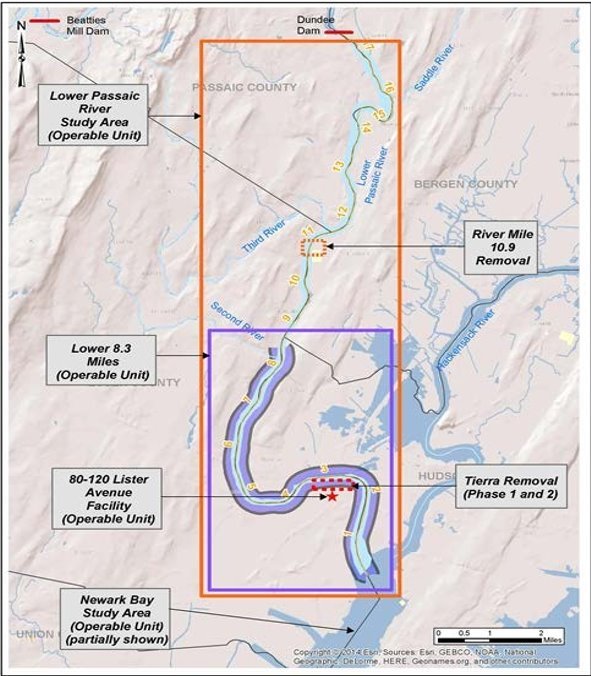EPA Extends Public Comment Period on Proposed Plan for Interim Action to Clean Up Contaminated Sediment in the Lower Passaic River Study Area of the Diamond Alkali Superfund Site, New Jersey
NEW YORK – The U.S. Environmental Protection Agency (EPA) has extended the public comment period for its proposed plan to address contaminated sediment in the upper nine miles of the Lower Passaic River Study Area of the Diamond Alkali Superfund site in Essex, Bergen, and Passaic Counties, New Jersey to June 14, 2021. The Lower Passaic River and the Diamond Alkali site include overburdened communities that are often disproportionately impacted by environmental health risks. EPA is committed to advancing environmental justice in communities across the nation by providing ample time for the public to review and comment on proposed clean-up actions.
The sediment in the Lower Passaic River is severely contaminated with dioxins/furans, polychlorinated biphenyls (PCBs), heavy metals, pesticides and other contaminants from more than a century of industrial activity. The proposed cleanup plan – supported by the New Jersey Department of Environmental Protection - calls for using a combination of cleanup technologies including dredging approximately 387,000 cubic yards of contaminated sediment. The proposed remedy would be an interim action – a final remedy would be selected after this action has been implemented, as described in more detail below. This proposed interim action complements the cleanup selected in 2016 for the lower eight miles of the Lower Passaic River. That cleanup includes bank-to-bank dredging and capping in that stretch of the river.
The proposed cleanup includes:
- Capping areas of contaminated sediment that have been identified as sources of contamination. Prior to capping, sediment would be dredged to a depth to accommodate the cap so that the potential for flooding is not increased.
- Additional capping and dredging in areas with the potential for erosion and high concentrations of contaminants in the subsurface.
- Areas identified for remediation would be evaluated to determine if sediments at depth in each area can be dredged so that capping would not be needed.
- Dredged materials would be processed at one or more nearby sediment processing facilities for off-site disposal at licensed disposal facilities.
- Institutional controls such as restrictions on activities in the river would be implemented to protect the cap, and New Jersey’s existing prohibitions on fish and crab consumption would remain in place.
- Monitoring and maintenance of the cap would be required to ensure its stability and integrity in the long term.
EPA will consider public comments received on the proposed cleanup plan and if the proposed cleanup plan becomes final, EPA will pursue agreements with the responsible parties to implement the interim remedy. EPA expects to use an adaptive management approach to sample and gauge the progress of the cleanup toward a final remedy for the Lower Passaic River Study Area, which would include assessing the river to determine if more work is needed to meet the goals of a final remedy for the Lower Passaic River. EPA would propose a final remedy for the entire Lower Passaic River at that time.
The Diamond Alkali Superfund site is divided into Operable Units (OUs). EPA often divides cleanup activities at complex sites into different areas or OUs: The Diamond Alkali Superfund site is currently organized into four OUs.
- OU1 is the location of the former Diamond Alkali pesticide manufacturing plant at 80-120 Lister Avenue, for which an interim remedy for containment was completed in 2001.
- OU2 is the lower 8.3 miles of the Lower Passaic River, from Newark Bay to river mile 8.3, for which EPA selected a remedy in 2016. The estimated $1.38 billion cleanup plan is currently in remedial design under EPA oversight.
- OU3 is the Newark Bay Study Area. EPA is currently overseeing an in-depth investigation of the bay, including the nature and extent of the contamination and the potential risks to human health and the environment from exposure to this contamination, and an evaluation of technologies and alternatives in order to determine how best to clean it up over the long term.
- OU4 is the 17-mile Lower Passaic River Study Area which includes both the lower 8.3 miles of the River and the upper nine miles which is the subject of this proposed plan. This proposed cleanup plan covers the upper nine miles of OU4 in the Lower Passaic River Study Area and is an interim action. A final remedy for OU4 will be proposed and selected in the future.

EPA held a public meeting to explain and to receive comments on the proposed plan on April 27, 2021 at 6:00 p.m.
Written comments on the proposed plan may be e-mailed or postmarked no later than June 14, 2021 to [email protected] or Diane Salkie, Remedial Project Manager, U.S. Environmental Protection Agency, 290 Broadway, 18th Floor, New York, New York 10007-1866
For more information on the site or to review the Proposed Plan, visit: www.epa.gov/superfund/diamond-alkali
Follow EPA Region 2 on Twitter at http://twitter.com/eparegion2 and visit our Facebook page, http://facebook.com/eparegion2.
21-025
